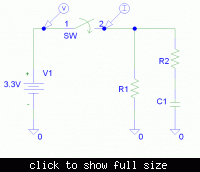- Joined
- Jan 22, 2008
- Messages
- 52,384
- Helped
- 14,746
- Reputation
- 29,774
- Reaction score
- 14,089
- Trophy points
- 1,393
- Location
- Bochum, Germany
- Activity points
- 297,935
Re: Confiused abou how to calculate effective power/voltage/current of a pulse wave
So you are saying that the oscilloscope waveform doesn't show the real module current consumption. Then we shouldn't discuss this waveform.
Once again, if a device is supplied with constant voltage, average power consumption isn't but average current multiply voltage.
Pavg = Vconst * Iavg
So the problem is about measuring average supply current.
So you are saying that the oscilloscope waveform doesn't show the real module current consumption. Then we shouldn't discuss this waveform.
Once again, if a device is supplied with constant voltage, average power consumption isn't but average current multiply voltage.
Pavg = Vconst * Iavg
So the problem is about measuring average supply current.
You are thinking too complicated.I believe the only way to calculate the effective power consumption having such a waveform is to Fourier transform the waveform and choose n to some number of accuracy and find out the rms for the different part of the Fourier series and sum it .. this is the only way to get a correct effective power consumption.
